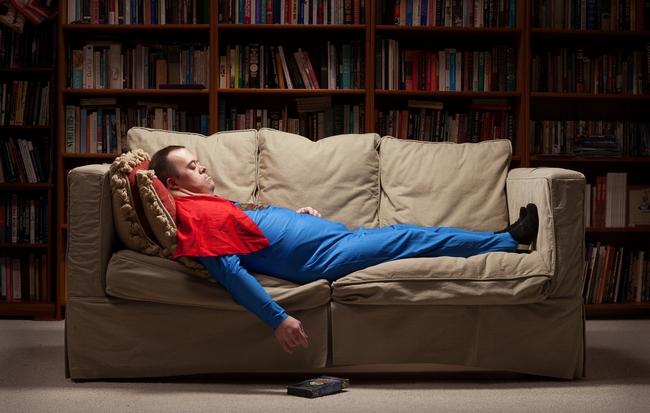Retired commercial photographer and Marblehead resident Rick Ashley’s studio in the Masonic Temple’s basement resembles a mishmash between a tidy creative space for him and a shrine to his brother-in-law, Michael Boulier, 51, who has Down syndrome.
In one portrait, a sophisticated Boulier, puffing a wooden tobacco pipe, sports a tweed jacket, beret and black turtleneck. Another depicts him smoking a cigarette as it dangles between his lips – James Dean style. In one corner, Boulier’s fingers fan out across his face the way authors do for book covers.
One portrait “Michael #145973,” capturing Boulier clad in a Superman costume and napping on a plush couch, is amiss from the collection and will remain so for some time.
That’s because a jury selected the portrait alongside 42 others – created by artists across the county – to hang in “The Outwin 2016: American Portraiture Today” exhibition of the National Portrait Gallery.
“I won’t see that portrait return to Marblehead until January 2018,” said Ashley in his studio Friday.
The triennial exhibition (also a national competition) places a pulse on contemporary American portraiture. Over 2,500 artists submitted portraits to the competition. The winning assemblage unifies a kaleidoscope of portraits in varying media, including film, photography, traditional painting and sculpture, in one spot.
“This is a big deal,” said Arnould Gallery and Framery owner Gene Arnould, who helped frame “Michael #145973” in preparation for the show’s Saturday opening and exhibition through January 2017 in Washington, D.C. “He is an incredibly talented artist – and has done some amazing work with Michael.”
The show travels to museums in Washington, Texas and Missouri after leaving the nation’s capital.
“Michael #145973” originated from a portfolio of more than a dozen photographs of Boulier that Ashley snapped between Annapolis, Maryland and Marblehead over six-year period. He then had them blown up in black and white and color, rendered as oil paintings and etched in pencil. Each examines assumptions that people draw from portraits, usually staged with subtle or overt visual elements – such as jewelry to indicate wealth or a dog as a symbol of fidelity – that the subject/artist uses to manipulate viewers’ perception. He argues that traditional portraits can contain superficial qualities as artificial as paid actors in Sunday infomercials. In other words, we should question what’s behind the wizard’s curtain.
He scaffolds his Michael images – especially the Superman ones – with stylistic elements and motifs found in a handful of iconic compositions – from Michelangelo Caravaggio’s biblical allegories to Salvador Dali’s melting clocks. In doing so, Ashley recontextualized pieces of art to interpret.

